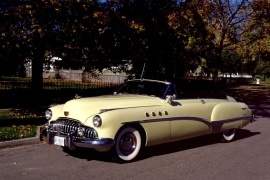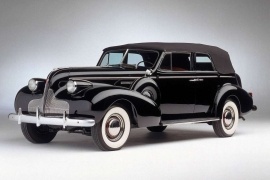BUICK Roadmaster Models/Series Timeline, Specifications & Photos
First production year: 1940
Engines: Gasoline
Body style: Convertible (spider/spyder, cabrio/cabriolet, drop/open/soft top)
Buick pulled the Y-Job concept-car drawings and created the 1949 Roadmaster, offering one of those times' most luxurious and comfortable rides.
When Harley Earl designed the Y-Job in 1939, he made the first concept car in the world, but it was more than that. It was a fully functional vehicle that Earl drove until 1951 when he replaced it. But unsurprisingly, the Roadmaster carried over many of the original design ideas and, moreover, it featured a similar engine under the hood.
With its timeless design, the Buick Roadmaster was not only an imposing presence on the road but also a vehicle that looked like it owned the road. Its chromed grille and rounded front fenders were flush with the doors and created a streamlined look. Moreover, the rear fenders were widened and covered more than half of the rear wheels to minimize drag. Also, the car sported the VentiPorts, which were four round vents on each front fender. These represented the number of cylinders under the car's hood, eight in Roadmaster's case.
The interior was lavish and luxurious, featuring leather bucket seats at the front and a comfortable bench in the back. Furthermore, since it was fitted with the standard Dynaflow automatic gearbox with the shifter mounted on the steering column, there was no obstacle between the front seats. Also, the power-operated roof was an exquisite, luxurious addition to the vehicle, increasing comfort.
Under the hood, the Roadmaster featured the same 5.2-liter inline-eight engine from the Y-Job, although it was slightly improved to offer 150 hp (152 PS). In addition, the two-speed Dynaflow automatic transmission provided a smooth gear change. Moreover, it also improved the car's riding quality and comfort.
Introduced in 1939 as a 1940 model year, the Roadmaster was one of the most luxurious cars available on the U.S. market, and it was a leap forward over its predecessor.
When Buick decided to introduce the third generation of the Roadmaster, it made it on the C-Body platform shared with the Cadillac Series 62 and the Oldsmobile Series 90. Even though it had a shorter wheelbase than the second generation of the Roadmaster, the new model was slightly longer and boasted a higher level of comfort and features. In addition, since it was a lighter construction than the second series, it provided better performance and improved fuel efficiency despite the fact that it had the same inline-eight engine under the hood.
When Harley Earl penned the 1940 Roadmaster, he created a few similar styling lines as those featured on the Buick Y-Job, the first concept car in automotive history. As a result, the third generation of the Roadmaster featured a torpedo-style bodywork with taller front fenders that supported the round headlights and a long, V-shaped engine compartment with a rounded front area curved down to mimic an eagle's beak. The grille placed on the lower side of the front fascia was extended from one front fender to the other, and underneath it, Buick placed a chromed steel bumper. Access to the cabin was made through four doors, while those in the back were rear-hinged. The car was available either with a retractable canvas roof or with a fixed metallic one. Behind the cabin, the automaker installed a tall and almost vertical trunk that was accessible from the outside.
Inside, Buick threw every luxury item it had in its basket. Its wide seats, genuine wood accents, and high-quality materials were accurately manufactured to create a classy ambiance. Buick's focus on passenger comfort extended to the car's spacious cabin, where ample legroom ensured a relaxing journey. In front of the driver, the automaker installed a wide instrument cluster where the speedometer took center stage flanked by a few gauges that showed temperature, oil pressure, voltage, and fuel level. The three-spoke steering wheel and the gear stick mounted behind it on the column allowed customers to cross the car from left to right on the bench seat. In the back, the three-person bench seat was comfortable, and the passengers seated on the outboard seats also had integrated ashtrays in their armrests.
Under the hood was the same inline-eight powerplant carried over from the Roadmaster's second generation paired with a three-speed manual transmission. For the 1941 model year, the automaker increased the power of the Fireball i8 engine from 141 hp (143 PS) to 165 hp (167 PS), more than what Cadillac or Pontiac offered on the vehicles made on the same platform.

